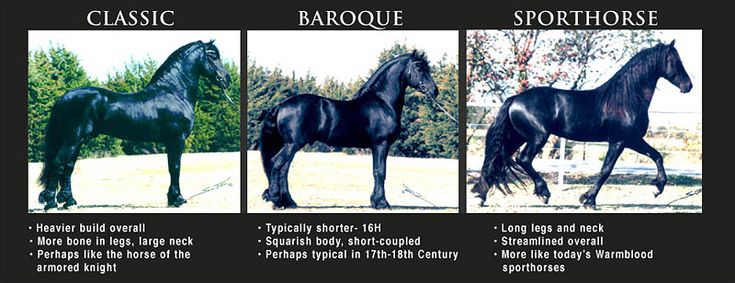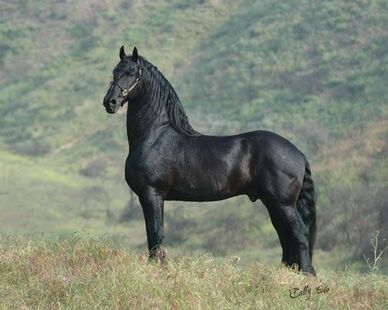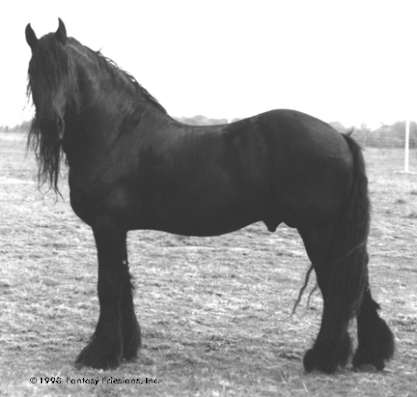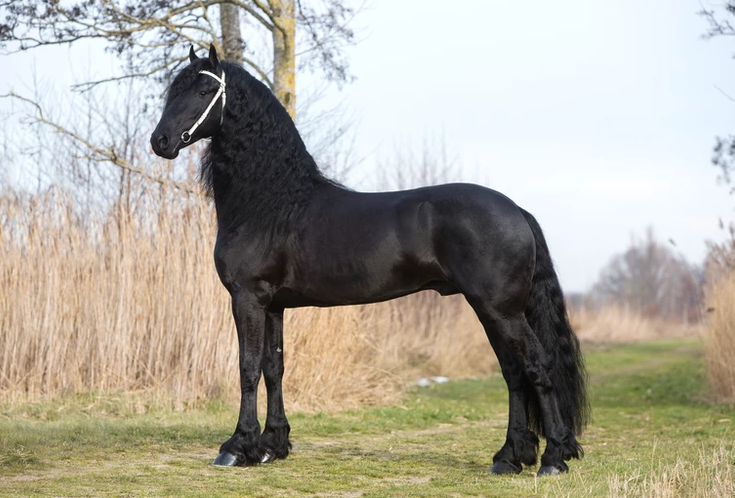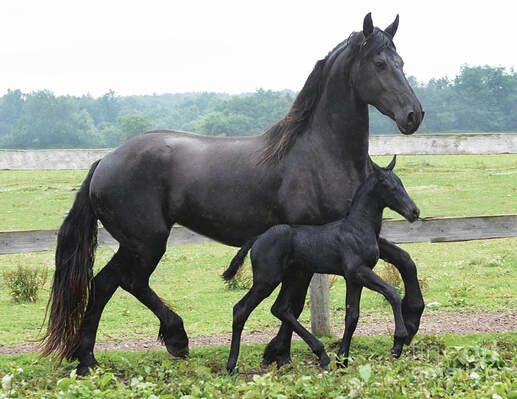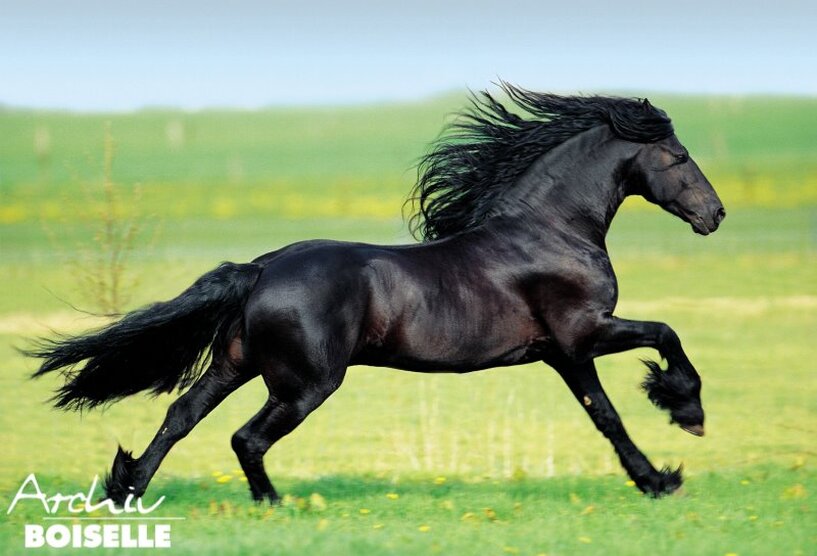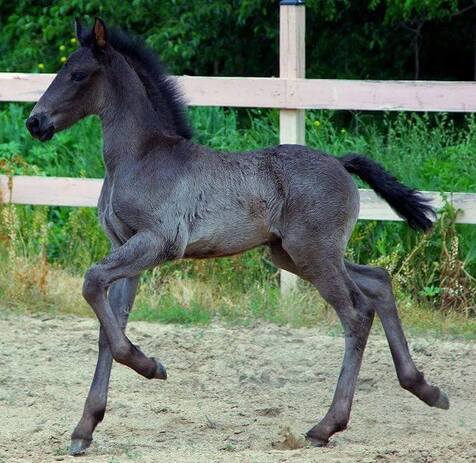"Different rules applied back then and were a bitter necessity in order to keep with the demands of the times. Luckily, characteristics such as luxuriance and noblesse were anchored deeply enough into the genetics of this ancient breed. These genes would play a more crucial role in the most recent and much happier phase of its history."
Physical Features ..
|
Friesians are primarily black but have existed in other colors such as bays, chestnuts, and possibly grey. And only a few chestnuts remain today. Per the KFPS, white markings are typically not allowed on the body or legs and only a small star less than 2 cm above the eye line is permissible.
They have a long, thick, flowing mane and tail and pronounced fetlock hair. Under no circumstance is it permissible to dock the tail of a Friesian and, in fact, trimming of any hair from mane, tail or legs is frowned upon. The Friesian Horse holds its head high and proud with an arching neck. The animated gait is natural. Selective breeding is used to achieve the active hock action and high, extended-from-leg action. |
|
The body is strong and deep with a sloping shoulder. The rear quarters are sloping with a somewhat low-set tail. Registered Friesian stallions must be at least 15.3 hands by the age of four and mares must be at least 14.3 hands. The mares average about 1300 lbs., more for males.
Midway through the last century the Friesian horse was used mainly as a harness horse in farming operations. For work under saddle and driving sports, a functional build is key. Because there is a close relation between an animal’s intended use and its exterior, Friesian horses that were bred for use in agriculture were more short-legged and compact than their ancestors, with forelegs a bit behind the vertical and a broad chest. With this broad chest, the horse was better able to throw itself “into the harness” and in so doing develop more pulling power. These exterior characteristics are less functional these days in the riding arena or in harness and driving horses. |
|
The horse’s body must also have an “uphill” slope. With this uphill build, the distribution of weight is brought more onto the hindquarters in motion, enabling the horse to carry more with its hindquarters. For an uphill build, a relatively long foreleg is important, as well as the stance of the foreleg. The stance of the foreleg is linked to the shoulder, whereby an angled and long shoulder provide the horse with space to extend its foreleg far out to the front. The harness horse often has a bit more vertical neckline than the riding and driving horse.
Nonetheless, the heavier and short-legged type is still much in evidence, partly because this type was bred for so many years and multiple generations are needed before it disappears from the breed. |
|
For an all-purpose horse, the Friesian must move fluidly through its entire body, with powerful hindquarters that transmits movements forward, enabling the horse to “grow” in front, a desired trait for both riding under the saddle and for driving in front of the wagon. For a harness horses, a lot of knee action is desirable (but not this alone, as it must be combined with spaciousness of gaits and “carrying” hindquarters), while for riding horses and also driving horses, extravagant knee action is not always appreciated. For all purposes, a correct leg stance is a must. |
Temperament ..
Next to its fantastic appearance, the Friesian horse has a character that is marked by intelligence, friendliness, adaptability and its enormous willingness to work for humans. It’s this character in particular that has contributed to the fact that through the centuries there have always been people willing to do anything to preserve the breed.
There is more than one correct way to spell "Friesian". Depending on region or country, these are common spellings: Friesian, Fries paard (Friesian horse), Friesch, Frisian, Frizian
The ultimate 'utility' breed ..
An excellent trotter, the Friesian was used for racing short distances in Holland, the winners being awarded silver or golden whips. Today in Friesland, there are many carriage events and often sjees, the Friesian form of the chaise, are seen. This unique two-wheeled cart may be drawn by one or two horses, and aboard are a gentleman and a lady dressed in the traditional costumes of the 1880s. The sjees is one of the few carriages in which the driver is seated on the left; his lady occupies the right-hand side, the place of honor. Four-in-hand carriages are common and as many as ten-in-hand can be seen in front of light carriages. These large, unusual hitches used for demonstration purposes are becoming very popular. The Friesian people take great pride in the natural ability of their black horse in harness.
These days, Friesians are becoming immensely popular and kept for purposes of recreation, breeding, sport, and often for some combination of these objectives. Both as a riding horse and as a driving and harness horse, the Friesian can deliver great performances!
The Friesian horse has increasingly developed into a sports horse over the past decades, and in so doing is returning to its origins before the agricultural interlude. It is fast becoming the luxuriant, aristocratic carriage horse it once was.
Typical of these black pearls are the front, the majestic mane and feathering of the lower legs, the jet black color and the spacious, powerful elevated gaits. The harmonious build and the noble head, set on a lightly arched neck, complete the aristocratic and fiery appearance. Its amicable character is the key to a great utility breed.
Today, thanks to its typical functional characteristics, the Friesian horse now competes with other breeds at the highest levels of equestrian sports.
Additionally, Friesian horses can be seen ever-appearing in many other disciplines - the are not strictly adhered to the world of dressage and harness. After taking a poll in a Friesian-based Facebook group, theses are all the other areas people at submitted:
These days, Friesians are becoming immensely popular and kept for purposes of recreation, breeding, sport, and often for some combination of these objectives. Both as a riding horse and as a driving and harness horse, the Friesian can deliver great performances!
The Friesian horse has increasingly developed into a sports horse over the past decades, and in so doing is returning to its origins before the agricultural interlude. It is fast becoming the luxuriant, aristocratic carriage horse it once was.
Typical of these black pearls are the front, the majestic mane and feathering of the lower legs, the jet black color and the spacious, powerful elevated gaits. The harmonious build and the noble head, set on a lightly arched neck, complete the aristocratic and fiery appearance. Its amicable character is the key to a great utility breed.
Today, thanks to its typical functional characteristics, the Friesian horse now competes with other breeds at the highest levels of equestrian sports.
Additionally, Friesian horses can be seen ever-appearing in many other disciplines - the are not strictly adhered to the world of dressage and harness. After taking a poll in a Friesian-based Facebook group, theses are all the other areas people at submitted:
|
Disclaimer: All images are Copyrighted to their original photographer and are only used to showcase the Friesian horse for educational purposes. No monetary gain is made from the display of these photos and they are not meant for redistribution.
This page was last updated on 2/22/2022.
This page was last updated on 2/22/2022.
